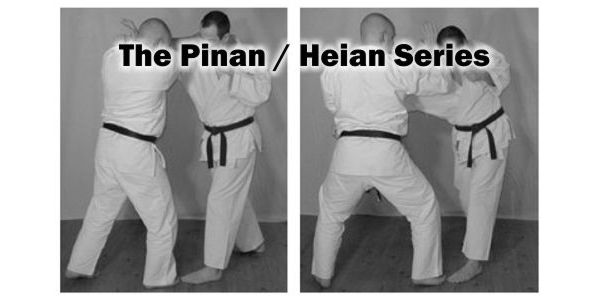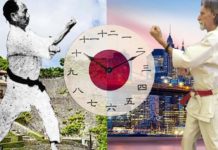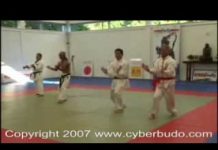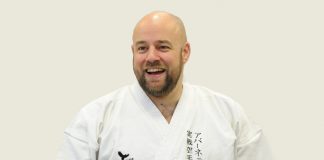In the first part of this series we examined how the Pinan / Heian katas represents a complete fighting system that contains techniques for use at all stages and all ranges of a fight. We also discussed that whilst the order in which the forms are taught today is based upon the relative technical difficulty of the solo performance of the katas (Pinan Nidan first), the original order is mainly based upon the progression of a live fight (Pinan Shodan first). If allowed to progress, a physical altercation will generally go through a series of stages: Pre-fight (verbal exchanges, aggressive body language), limbs coming into range (strikes, attempted grabs etc), grips being established, and finally grappling.
Pinan Shodan (Heian Nidan in Shotokan) predominately deals with the initial exchange of limbs. In part one, we saw a couple of applications from Pinan Shodan that illustrated this idea. We will now move on to discuss a couple of the applications of Pinan Nidan (Heian Shodan) kata. This kata progresses from the initial exchange of limbs and mainly deals with techniques that can be used when a grip has first become established. This can either mean you securing a grip on the opponent, or the opponent securing a grip on you.
The very first movement in the form deals with a surprise attack from the rear. Because you have been taken by surprise, you have been unable to deal with the initial exchange of limbs and the opponent has secured a grip around the tops of your arms. After distracting the opponent with either a rear head-butt, stamp to the feet, reaching back and grabbing the testicles etc, wrap your fingers around the opponent’s index finger (Fig 1). Bend the opponent’s finger back and raise your arms in order to break their grip (Fig 2). Assume long cat stance – which will position you so that your elbow is in line with the opponent’s centre line – and deliver a rear elbow strike (Fig 3). A hard strike anywhere along the opponent’s centreline is likely to do significant damage.
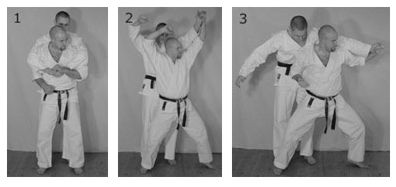
In part one, we saw how the shuto-uke or ‘knife-hand block’ can be used to redirect an opponent’s attempted grab and open them up for a strike. If we have been unsuccessful at avoiding an opponent’s attempt to grab us, Pinan Nidan (Heian Shodan) contains techniques we can use at that stage of the fight.
The opponent has managed to secure a grip upon your clothing. The ‘rising head block’ can be used to counter this grip (Fig 4). Trap the opponent’s wrist (as in hikite) and strike the inside of the opponent’s upper forearm using your free arm. As you deliver the strike, step backward into Zenkutsu-dachi (basic front stance) in order to put bodyweight into the strike and to position the body so that you are less vulnerable to being struck by the opponent’s head. This movement will cause the opponent’s head to shoot forwards and turn. The opponent’s free hand will also be made to shoot backward. This will prevent the opponent from effectively delivering any rear hand strike (Fig 5). The ‘rising block’ is then performed. The forearm will hit the opponent’s jaw as their head drops forward (be very careful in practice). This is a very powerful strike that requires little skill in the way of accuracy because the forearm is such a large striking weapon and the opponent’s most likely response is considered (Fig 6).
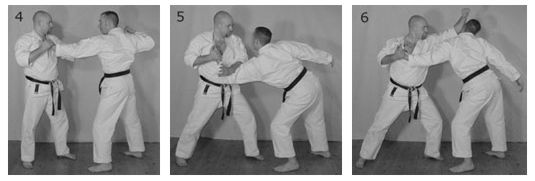
The examples so far show how movements from Pinan Nidan (Heian Shodan) can be used when the opponent has grabbed you. The kata also contains numerous techniques that can be used when you have secured a grip on the opponent. The following technique is an application of the ‘lower-blocks’ and punches found after the three ‘rising blocks’.
During the fight, your arms have clashed with the opponent’s arm. You have seized the opponent’s wrist and positioned your forearm above their elbow (Fig 7). Pull the opponent’s hand to your waist as you rotate their forearm. Keep your forearm in contact with the opponent’s arm and push down and around in an arcing fashion. As you rotate the opponent’s forearm, the position of their elbow will also rotate. It is for this reason that your pushing arm must move in an arc in order to keep applying pressure to the correct point. This rotation of the arm makes it very difficult for the opponent to resist the lock due to the constantly changing direction of the force. Step around with your back foot in order to add bodyweight to the technique and to increase your mechanical advantage. This is the application of the ‘lower-block'(Fig 8). In Wado-Ryu and Shito-Ryu the technique is normally performed at a forty-five degree angle. In Shotokan it is performed at a ninety degree angle. Both work. Now that the opponent is off balance and their head has dropped down, you should seize the opponent’s shoulder and apply a downward pressure. This will ensure that you maintain control over the opponent and it will prevent them from regaining an upright position. Step forwards and deliver a strike to the base of the opponent’s skull (Fig 9).
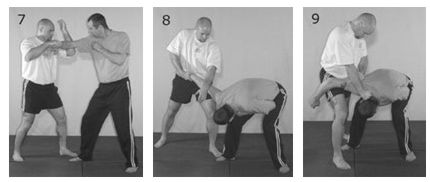
In part one of this series of articles, we discussed the background to the Pinan / Heian Series and saw how Pinan Shodan (Heian Nidan) contains techniques for use during the initial stage of the fight where the limbs are being freely exchanged. If the fight progresses beyond the free exchange of limbs, the next stage tends to be the establishment of an initial grip. As we have seen, it is this stage of the fight that Pinan Nidan (Heian Shodan) predominately focuses on. Once a grip has been firmly established it is normal for the fight to quickly move into grappling / fighting from a clinch. As we shall see in part three, Pinan / Heian Sandan is a grappling kata that contains many techniques for use at that range. It is hoped that you are beginning to appreciate the logical progression of the Pinan series, the highly effective techniques they contain, and that this series of katas does indeed represent a coherent fighting system.

